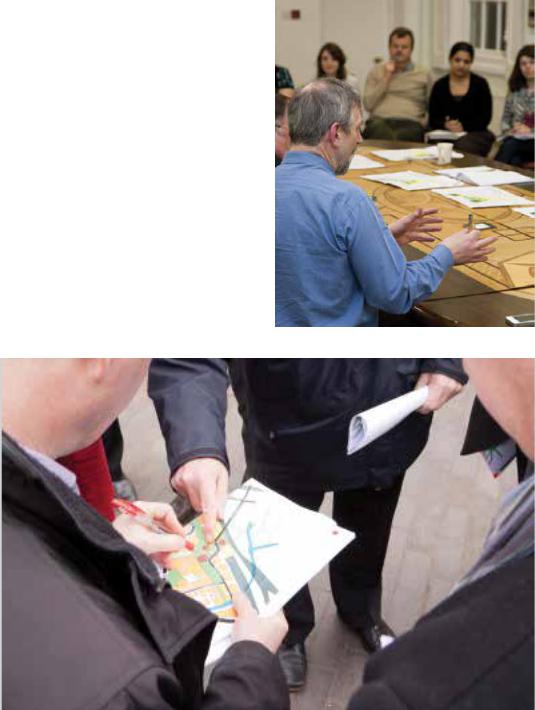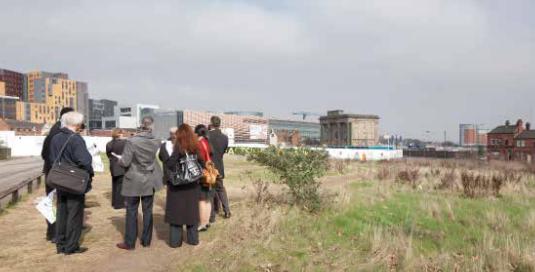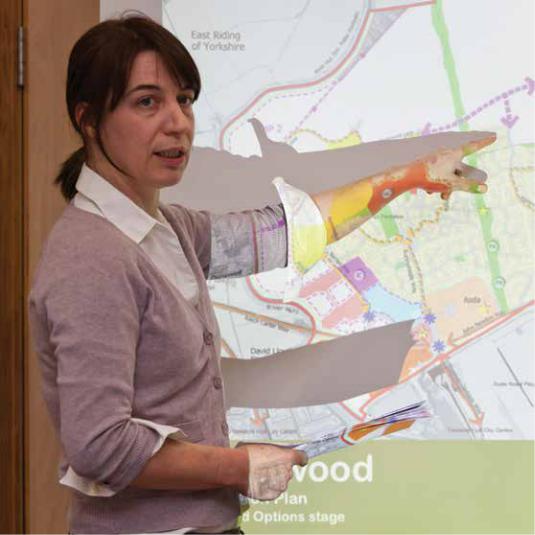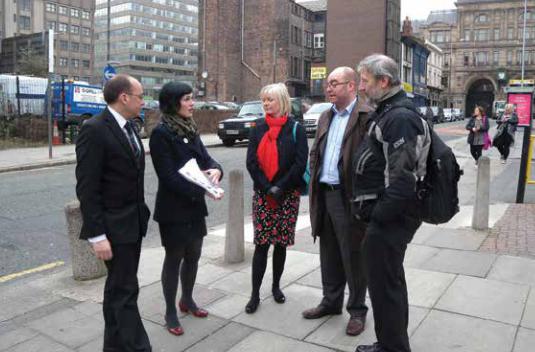
attachment_8
.pdf
Chapter 3
Whobenefitsfrom
Design Review?
Design teams and local planning authorities routinely seek advice from advisory bodies and statutory consultees such as English Heritage, Natural England and amenity societies. Design Review does not replace the insights and expertise of these bodies.
Rather, it offers additional breadth of vision and support on issues of design to aid decision making in the planning system. The strength of a design review panel’s advice lies in its independence, objectivity and ability to analyse a scheme within the context of wider good practice and knowledge of exemplars from further afield.
Local authorities
Whether it is carried out at the preapplication stage or after an application has been lodged, Design Review enables local planning authorities to ensure that developers and design teams produce high-quality, inspiring buildings and public spaces. It helps them to recognise
outstanding and innovative design, supports them in resisting poor design and gives them a practical means of understanding where improvements need to be made.
When a planning authority is fully engaged in the review programme, its confidence in assessing and dealing with design issues grows substantially.
As well as helping local authorities to assess projects submitted to them, Design Review can support them in their role as clients, helping them to secure high-quality design in public buildings such as schools, libraries and sports facilities, and in the streets and open spaces for which they are responsible.
Developers
Professionals from both the public and private sector will usually welcome timely and constructive analysis of their designs and the direction of their projects. The value of Design Review has been acknowledged by organisations ranging from Government departments and national agencies responsible for advising on or commissioning large capital programmes to speculative developers creating commercial, residential and mixed use projects.
The review process helps developers by reducing the risks and costs of delays in the planning process that can result from inadequate design quality. It draws attention to opportunities for design changes that could significantly raise the overall quality of the proposals in very cost effective ways, and make the completed scheme more satisfactory for its users.
The strength of a Design Review
panel’s advice lies in its independence,
objectivity and ability to analyse a scheme”
Who benefits from Design Review?9

Project design teams
Design Review gives constructive, impartial, advice to architects, urban designers, landscape architects and other design practitioners from fellow professionals who are able to examine the project design from a variety of perspectives and at sufficient distance so as to offer a fresh viewpoint that can identify design issues which the project designers may be too close to see. The process supports good design intentions and pinpoints any opportunities and weaknesses that may have been missed.
Community groups
Large or high profile projects often generate considerable public interest. A design review panel meeting held in public is not an alternative to a programme of community engagement, but it can be a useful part of it.
It can help to show the virtues of well thought out planning, and demonstrate how design can reconcile the aspirations of different interest groups.
The Localism Act 2011 introduced important newpowersforcommunities.Itgavethem therighttoproposesmall-scale,sitespecific, community-led developments and shape new development by coming together to prepare neighbourhood plans.7 Design Review provides a valuable means of exploring neighbourhood plans and advising on how fully they will meet community aspirations.
The National Planning Policy Framework expects that those applying for planning permission should work closely with the people who will be affected by their
proposals, and bring forward designs that take account of the views of the community. Proposals that can demonstrate they
have done this should be looked on more favourably.8 Independent advice from a design review panel can not only provide useful guidance on community consultation, it can provide insights into how designs might impact on community life.
7.https://www.gov.uk/government/policies/ giving-communities-more-power-in-planning- local-development
8.NPPF para 66
10 Who benefits from Design Review?

Chapter 4
Local and national Design Review
9.The Design Network comprises Creating Excellence (South West), Kent Architecture Centre (South East), Integreat Plus (Yorkshire and the Humber), MADE (West Midlands), North East Design Review & Enabling Service (North East), OPUN (East Midlands), Places Matter (North West) and Shape East (East of England). The Cabe team at the Design Council delivers Design Review for London. Contact details for
these organisations can be found on page 28.
The National Planning Policy Framework advocates that all local authorities and developers have access to appropriate Design Review arrangements and use this to ensure high standards of design. The last few years have seen a large increase in the number and type of panels operating in England. Anyone who wants to have a scheme reviewed therefore needs to know the appropriate panel to use.
Local Design Review arrangements
Local Design Review arrangements across England vary in availability and organisation. Sometimes panels are managed and funded by a local authority or a group of local authorities, and sometimes they are run independently.
IndependentDesignReviewiscurrently offeredbynineorganisationsworkingtocover all of England.9 These panels usually focus
onschemesofregionalsignificanceorthose that raise more than local considerations. Obligations include adherence to best practice in Design Review to deliver consistent and high quality advice. These panels may provide a secretariat for a local authority funded local panel, in addition to training and sharing of panel members. This enables an arms-length relationship to be maintained between the Design Review panel, the planning department and decision makers.
There are several parts of England where more than one Design Review panel operates. Generally the type and size of scheme reviewed by each different panel is very clear, but there will be circumstances when co-ordination is needed between them to decide who should review a scheme.
National Design Review
National Design Review is currently provided by the Cabe team at the Design Council. Cabe’s remit includes projects that are eitherofnationalsignificanceorwillhavea profound impact on their regional and local environment. Such schemes may range from urban extensions to town centre mixed-used developments. Frequent communication between Cabe and other panels ensure that
schemes are reviewed at the appropriate level.
From time to time, specialist panels can be set up to cover particular areas of activity. To date, these have included the London 2012 panel, the London Crossrail panel, the Ecotowns panel and the Building Schools for the
Future panel.
Whoreviewswhat?
Panels need clear lines of communication to ensure that schemes are reviewed by the most appropriate panel. The review of a scheme by more than one panel should be avoided. This would duplicate time and effort, and introduce the risk of confusion from potentially conflicting advice.
It is essential for panels to be aware of others operating in the same area. Sometimes, it will be helpful to agree a protocol between panels operating in their locality, to provide clear criteria on which sizes and types of schemes should be referred to each panel. The protocol would set out the procedure for making these decisions, and state how the panels will be consulted. It could also set priorities for review, such as housing or town centres. Where appropriate, a subsidiary themed panel might be set up to deal with specific or recurring needs.
The NPPF advocates that all local authorities and developers have access to appropriate Design Review arrangements”
Local and national Design Review 11

Part Two:
Design Review in practice
© Ben Blossom

Chapter 5
Delivering the principles
There are ten fundamental principles of Design Review, and each one has practical implications for the appointment of panel members and the management of the review process.
Independent
The panel must be free to say what it thinks about any scheme, and its independence should be evident to all.
Conflictsofinterest
If the panel’s advice is to be respected, its members must be demonstrably impartial.
All conflicts of interest, real or perceived, should be formally and rigorously dealt with and recorded well in advance of each meeting. A conflict arises if there is any suggestion that a panel member, either as an individual or a member of a group or organisation, might have a financial, commercial or professional interest in a project, its client or its site.
The panel should draw up a standard policy for dealing with conflicts of interest. Cabe, local planning authorities and other panels can all be asked for advice on writing the policy. It should set out clearly how interests will be identified, recorded and managed, and it should be publicly accessible,
ideally online. Conflicts of interest can be a particularly sensitive issue in local panels, where many panel members will work
in the same area as the projects under review. In cases where panel members are associated with a planning authority, have a financial interest in a scheme, or have declared support for it at councillor level, it may be advisable to refer the project to an
independent panel that operates with a wider remit outside the immediate locality.
Funding
Design review panels can have more than one source of funding. Initially they were maintained by public money, but now this is increasingly being topped up or even replaced by other income. For example, fees paid by the developers and promoters of schemes, or a proportion of the charge for pre-application advice or via a Planning Performance Agreement. To safeguard
the reputation of the panel and the weight that should be given to its advice, it is crucial that the funding arrangements are clear and open. In some cases it may be a good idea to establish an independently administered fund. Provided that a panel’s governance arrangements adhere to the principles set out here, there should be no risk of the panel’s integrity or advice being compromised by the funding stream. The funders, especially when they are also the developers, must be aware that the panel’s independence is unconditional.
It is important that panels do not underestimate how much funding they will need. Even if members are giving their time free or for a modest fee, adequate resources are required to provide a professional service. If core costs are to be met from a single source, panel operators should map out the resources they will need in order to deliver Design Review to the standards set out in this publication.
Costs to consider include
• the salaries of skilled and properly trained staff.
• payments to panel members. As
a minimum, travel expenses should be covered.
• hire of venues and purchase of presentation facilities.
• induction and training expenses for staff and panel members.
Staffing
Where panels are run directly by local authorities, it is preferable for the panel to be managed corporately, detached from the council’s development management function. Panels that are sponsored by, or closely linked to, a local planning authority or other agency must deal with the crucial but sensitive issue of maintaining independence from it.
Delivering the principles 13
Expert
Selecting the panel
A panel is only as good as its panel members, and if it is to provide clear, objective advice it is imperative that the right mix of skills and experience is found. As well as getting the right blend of skills, it is essential to appoint a good chair and identify any training needs.
Appointing the right panel and chair demands an open and robust recruitment process. To review schemes effectively, in the round, a panel needs a diverse range of personalities and an equally diverse range of professional skills and opinions.
Note, however, that if elected members of associated planning authorities stand as panel members there is a danger that this could blur the lines of democratic accountability and lay the panel open to charges of conflict of interest.
Recruiting the panel
It is best to recruit suitable candidates through advertisements in the professional and local press. Focus on achieving a balanced representation of skills, experience and background. Direct invitations or nomination should only be used as a backup if the calibre of applicants falls short of the required standard.
The group whose task it is to select the panel members should themselves represent a widespectrumofprofessionals.Itshouldalso include at least one person from outside the immediate panel organisation, nominated by the panel’s commissioning body or steering group. This might be a representative of another panel (such as one of the Design
Networkpanels)orsomeonefromRIBA, RTPI,theLandscapeInstituteorCabe,the four organisations who have between them produced this guidance document.
Applicants should be sent an information pack or directed to a web page that sets out the selection criteria and the panel’s terms of reference. Particular care should be given to selecting a panel chair. The factors which must always be considered when appointing panel members include merit, independent scrutiny, equal opportunities, probity, openness and transparency, and proportionality.
The size of the panel
Most panels operate a pool system, so that members are not expected to attend every meeting. The number of members should reflect the expected workload of panel meetings,withfourtosixmembersateach.It is hard to have a focused discussion with the active participation of eight or more people.
However, panels operate more effectively if members can get to know each other and develop mutual understanding, so the pool should not be too large. Try to ensure that each member attends at least two design review meetings a year.
Thetermofoffice
Members should be appointed for fixed terms, usually three years, and for a maximum of two terms. When starting up a panel, it might be wise to appoint members for different periods so that not everyone stands down and is replaced at once, and new members have the chance to work alongside more experienced ones. A new chair should be given on the job training, working alongside the current chair, before taking over.
Sharing members
Local panels may find it helpful to share members who have particular skills and expertise in areas like transport planning or sustainability. To organise that efficiently, it would be useful for local panels to maintain a directory of members for all the panels in their areas.
Providing training and guidance
A well-planned induction procedure will allow new panel members to discuss procedures and probity, and give them a chance to observe a review meeting before they participate themselves. This will help them to understand the design review process and their role in
it. Additional training sessions, addressing specifictopicssuchassustainability,canbe organised where necessary.
Training for the panel’s professional staff should be provided by an expert, nationally recognised agency. Joint training sessions for a number of local panels may be the most efficient way of organising this. All panel members and professional staff will need a clear understanding of the regional, subregional and local issues, and the priorities of the planning authorities, in their area.
14 Delivering the principles

Appointing a good chair
It is important for all meetings to have an effective chair who is a highly regarded professional. The chair must be able to win the respect of the other panel members, and should have the ability to integrate a range of views and draw a coherent conclusion for each presentation.
A good chair will have
• a record of achievement that commands the respect of design review clients and fellow panel members.
• strong critical and analytical abilities.
• the people skills required to chair a meeting politely yet authoritatively, so that participants feel they are being listened to and understood without being allowed to dominate the discussion.
• the ability to deal with panel members or clients who express strong – and sometime differing – opinions.
• the skill to synthesise and summarise disparate or conflicting views, and reach a consensus.
• the ability to write clear, understandable reports summarising the meetings’ conclusions.
A panel may have more than one chair. Several members may take turns of chairing meetings, and many panels use a chair and deputy chair structure that offers cover for holidays and other absences. It also ensures that there is a successor ready when the chair stands down.
Multidisciplinary
Getting the blend right
One core principle of Design Review is that it offers advice from a diverse range of experts with a broad spectrum of professional skills and experience. This is an essential feature of the rounded, big-picture assessment
it provides. There are several factors that should be considered in organising a panel.
The mix of skills
As well as recruiting architects, it is essential tobringinmembersfromrelatedfieldssuch as planning, landscape architecture, urban design, the historic environment, sustainability and environmental services, accessibility, civil and structural engineering, transport, public art and property development.
Specialist experience
Some schemes may have to be reviewed by specialist panel members. Hospital developments, for example, will need people with a detailed understanding of hospital
design.Betweenthem,membersofthepanel should have specialist experience across both private and public sectors, with an understanding of how their specialist area is affectedbytheplanningsystem,commercial considerations and up-to-date procurement methods. Knowledge of government policy is also helpful as a backdrop to much public sector development.
Delivering the principles 15

Communication skills
As well as having expertise and a record of achievement in one or more professional fields,panelmembersmusthavegoodcritical abilities and be articulate in discussing design issues. Teaching experience in a professional context may be valuable.
Diversity
It is vital that the make-up of a panel reflects the diversity of the community that it serves. In advertising for panel members, it should be made clear that applications are welcomed from all sections of society regardless of gender, ethnicity or sexuality. A diverse range of ages can also be beneficial to the panel’s deliberations.
Local knowledge
Local panels will want to recruit some members with good knowledge of the local context. However, it is also advisable to appoint some panel members from outside the local area or region, to bring a wider perspective andensurethatabalanceofviewsisonoffer.
Sometimes, there may be opportunities to co-opt members from other panels to draw in special knowledge of a locality.
Embracingdifference
It is healthy for panels to reflect a range of different views and backgrounds. The members should be able to function as a group, but a panel where all the members agree with each other all the time is unlikely to be effective.
16 Delivering the principles

© Charlotte Myhrum
Accountable
Public scrutiny
Design review panels scrutinise schemes on behalf of the public. They should therefore be public, open and transparent about the work they do.
Establishing a governance structure
A design review panel must be seen to be independent from both the local planning authority and the developer, free to give impartial advice to all parties. A panel set up as a part of its funding body may find it
difficult to maintain its autonomy, particularly if the funding body is also a planning authority or investor. If this is unavoidable, robust arrangements should be set up to safeguard the panel’s independence and
to avoid conflicts of interest. Governance by an advisory board or steering group representing key stakeholders and acting solely in the public interest is one effective way of ensuring accountability.
Transparent
Setting clear terms of reference
A design review panel should give advice to all parties involved in a project. It is not an alternative to the democratic planning process, nor an adjunct to a developer’s design team. It should be made clear, at the
start of each review, who will be given advice and how that advice will be provided.
The terms of reference, funding arrangements, governance and key principles should be laid out in the panel’s brochure or website. The terms of reference may include any or all of the following.
•The overall aims of the panel.
•The geographical area covered.
•How the panel is managed.
•The membership of the panel.
•Who may attend meetings, including the policy on observers and other interested parties.
•How conflicts of interest are dealt with.
•What the panel’s output from the meeting will be.
•Confidentiality statements.
Delivering the principles 17

Balancingconfidentialityandpublic scrutiny
Design review panels act in the public interest, and must be clear and open about their constitution, procedures and deliberations. Their reputation depends on this. When considering schemes that have already been submitted for planning approval, the panel should make its advice report publicly available as soon as it has been sent to the planning authority, client and project team. The report can be made available either on request or published via the panel’s website or other media.
When schemes are reviewed before the planning application stage, the promoter often requests a confidential review. This is particularly likely where a scheme is not yet public and the developer feels that publicity may damage commercial interests.
The panel should offer Design Review in confidence at this stage. Knowing that the proposals will be treated as confidential will encourage developers to seek advice early in the process, when it will be most valuable.
However, a confidential review should certainly not exclude the planning authority as it is very important that it participates in the process. If, after a confidential review, the promoter makes any part of the panel’s confidential written report public, the panel should immediately release the entire report.
Local residents, heritage and other concerned groups and the media will always take a
keen interest in new development proposals. Design Review should always operate effectivelyforthegeneralpublicgood,rather than in the interests of particular individuals or groups. The panel should seek the best design outcome for the whole community, andconfidentialityoftenhasanimportantpart to play in allowing this to happen.
Dealing with freedom of information
The Freedom of Information Act 2000 provides a general right of access to information held by public bodies, with the aim of making their activities more transparent. Requests for information may come from the public at any time and panel staff should be prepared for them,
particularly when dealing with schemes that might arouse controversy.
Design review panels should be clear from the outset whether or not they are subject to requests for information under the Act. They may be obliged to disclose information even if the panel’s advice was
initially given on a confidential basis, so it is important to keep full records of all projects, procedures and comment.
There are, however, exemptions under the Act which may be relevant to requests for design review information. Staff should familiarise themselves with the relevant parts of the legislation and adopt a legally sound policy of dealing with requests,
including those about confidential reviews.
Each case will have to be considered individually and any decision to withhold information may be challenged.
18 Delivering the principles
